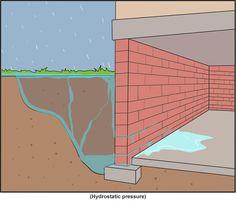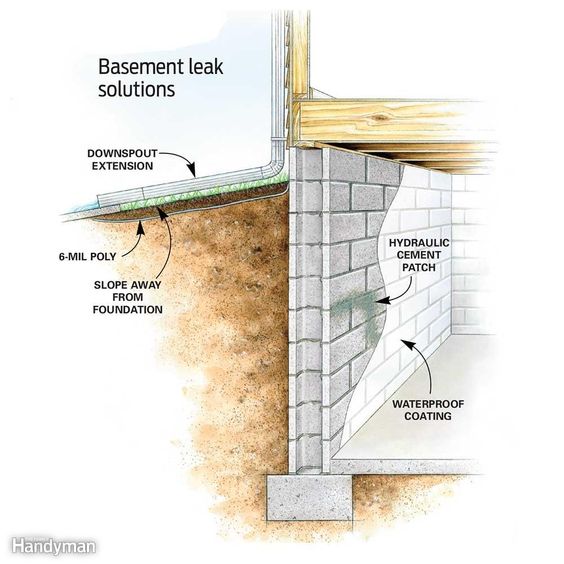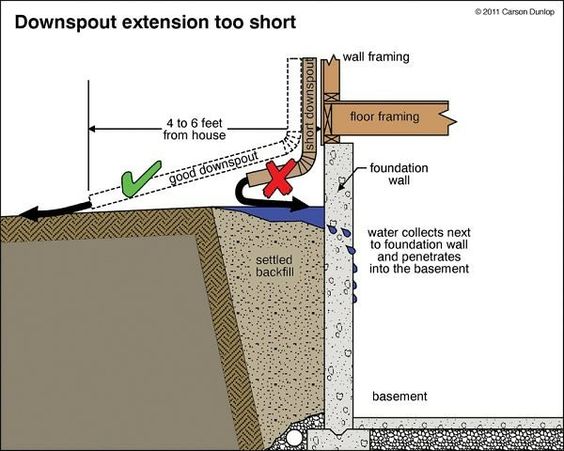To stop water damage and mold growth, you need to protect your basement. It includes fixing any cracks and putting in drainage systems to keep the basement dry and stop water from getting in.
For safety and health reasons, keeping your basement safe from water damage is very important. Keeping the house in good shape and raising its value are two benefits. In addition, preventing water damage can save people from having to pay for costly repairs in the future.
This comprehensive article on sealing a basement will cover all the various approaches, things to consider, and advantages of this significant home improvement job. You can use the information in this guide to make smart decisions that will keep your basement dry and safe, whether you have water problems or just want to keep your property safe.
Understanding Basement Waterproofing
To make sure that your house lasts and stays structurally sound, you should know how to protect your basement. A clean and waterproofed basement saves your things from water damage, keeps the house healthier, and keeps water damage from happening. In this complete guide, we will discuss all the important aspects of waterproofing your basement, including why it is necessary, the most typical causes of water issues, and the most effective solutions.
Importance Of Basement Waterproofing
Keep water out of your basement by sealing it. If water gets in and stays there, it can grow mold, damage the structure, and make the air quality bad. That way, you won’t have to pay for pricey repairs down the road and your home’s foundation will be safe. The value of your house goes up and you have more space for living or storage if you waterproof your basement. Why people often have water problems in their basements
Most of the time, a high water table, bad draining, and not enough covering are to blame for basement water problems. Leaky pipes, heavy rain, and melting snow are some other ways water can get in. You need to know these reasons in order to come up with good sealing solutions for your basement problems.
Signs And Symptoms Of Basement Water Problems
A basement that is always wet can be a real pain for homes. If you don’t pay attention to the signs of moisture problems, they can cost a lot to fix and put your health at risk. By spotting the early warning signs and taking steps to protect, you can avoid a disaster. Watch out for these main signs that there is water in the basement:

Dampness And Musty Odors
Most of the time, when there is water in the basement, it will be damp and smell musty. If there is any sign of water, like a wet floor or a general feeling of wetness in the air, it should be fixed right away. Mold growth and musty smells are often signs that the basement has too much water.
Mold And Mildew Growth
It’s clear that water is getting in if you can see mold and mildew growing on wall, ceiling, or other surfaces. Not only does mold growing in the basement damage the house, it also puts people’s health at great risk. It’s important to fix the source of water leaks to stop mold from growing and keep the air inside healthy.
Efflorescence On Walls
If water gets into a basement, it leaves behind efflorescence, which is a white powder that sticks to the walls. As the water goes away, it leaves behind this residue made of the minerals it brought. People who know that efflorescence means their basement has water problems are more likely to hire waterproofing professionals to get rid of the water source.
Types Of Basement Waterproofing Systems
To keep your home’s value and structural stability, you should waterproof your basement. When you shut off your basement, there are different types that are all meant to keep water out and mold from growing. Here are some of the most important types of sealing systems for basements that will really keep your space safe.
Interior Drainage Systems
Putting in an internal drainage system is a common way to keep water out of the basement. To get the water to a sump pump, a ring drain is put around the inside of the base walls of this system. Water doesn’t build up around the floor because this pumps water out of the basement. Interior draining systems make it easy to deal with groundwater and hydrostatic pressure.
Exterior Waterproofing Membranes
Outside waterproofing materials put on the base’s outside walls stop water from getting in. The base is well sealed by these membranes, which keep water from hurting it. Different things can be used to make them, such as polymer-based sheets, asphalt-based coats, or asphalt that has been hardened. Exterior waterproofing materials help keep the basement dry and safe by stopping water from getting into the building proper.
Sump Pump Installation
Putting in a sump pump is one way to keep water out of the basement. When water comes up in a sump pit, which is usually in the basement floor, a sump pump is used to get rid of it. The sump pump moves water out of the pit and away from the base when the water level rises. People can rest easy knowing that this practical way of getting rid of water can help keep their basements from flooding and getting water damage.
Waterproofing Basements From The Inside

When waterproofing a basement, it’s important to pay attention to the inside of the floor. By fixing any problems with water getting in from the inside, residents can avoid expensive damage and make their homes healthier. We will talk about three important ways to waterproof basements from the inside in this guide: Crack Injection, Interior Waterproofing Sealants, and Interior Basement Drainage Systems.
Crack Injection
Filling cracks with water is a good way to protect basements from the inside. Cracks in the basement walls need to be filled with special polyurethane or epoxy shots. In this way, it makes a wall that keeps water from getting in through the cracks and damaging the inside of the basement. This process also helps to strengthen the walls, which stops them from falling apart even more from water damage.
Interior Waterproofing Sealants
Another important part of sealing a basement is using interior waterproofing sealants. The purpose of these sealants is to protect against wetness by being applied to the inside walls and floors. They create a waterproof membrane that keeps water from getting into the basement walls and foundation when they are put down properly. This proactive method to waterproofing the inside of a building can greatly lower the chance of water damage and mold growth.
Interior Basement Drainage Systems
Putting in inner basement drainage systems is a proactive way to stop water from getting in from the inside. Drainage pathways and sump pumps are usually part of these systems. Their job is to collect water and move it away from the basement. Interior drainage systems are very important for keeping basements dry and safe because they work well to control water buildup.
Exterior Waterproofing Solutions
In order to keep your basement dry and safe from water damage, exterior waterproofing options are an important part of a complete plan. Water coming in from the outside is what exterior waterproofing is all about stopping. This can be very dangerous for the structure of your basement. The best way to protect your basement from water and flooding is to use effective exterior waterproofing options.
Excavation And Waterproofing Coatings
Some of the most important parts of waterproofing the outside are excavation and waterproofing coats. In order to get to the outside walls of the basement, excavation includes digging around the foundation’s edges. With this, the base can be carefully checked for any cracks, holes, or other problems that might make it less waterproof. You can add an extra layer of protection against water damage by putting waterproofing coats on the outside walls. Water can’t get through the foundation walls and weaken the floor because of these coatings.
Exterior French Drains
Installing outdoor French drains is another important part of waterproofing the outside. Around the foundation, these drains are put in place to catch water and send it away from the floor. By sending water away from the foundation, French drains lower hydraulic pressure and make it less likely that water will leak into the basement. By taking this preventative step, you can protect yourself against flooding and water getting in.
Downspout Extensions And Grading
Along with digging and installing French drains, pipe extensions and grading are also important parts of waterproofing the outside of a building. If you have the right downspout extensions, rainwater will flow away from the floor and not pool around the walls of your basement. Grading, the process of making the ground around the foundation rise away from the house, also keeps water from building up near the basement. All of these steps work together to make outdoor waterproofing more effective, lowering the risk of water damage and moisture getting in.
Foundation Repair And Waterproofing
Fixing the foundation and drainage are important parts of keeping a safe and sound basement. Finding and fixing foundation problems as soon as possible is important to keep your home’s structure and stop water damage. This guide will go over the main steps of foundation repair and sealing, such as finding problems with the foundation, fixing cracks in the foundation, and ways to keep foundation leaks from happening.
Identifying Foundation Issues
Finding problems with the foundation is the first thing that needs to be done to fix any possible entry spots for water in your basement. Cracks in the walls or floors, floors that aren’t level or slope, and doors or windows that won’t open or close are all common signs of foundation problems. Before you fix any problems with the floor that might be letting water in, you should carefully check your basement for warning signs.
Foundation Crack Repair
Fixing foundation cracks is an important part of sealing a basement. Cracks in the base can let water in directly, which can cause leaks and moisture buildup. Depending on how bad the cracks are, they might need to be fixed with epoxy shots, special sealants, or carbon fiber strips to make them stronger. Fixing foundation cracks right away can help keep your home’s structure strong and prevent water damage.
Preventative Measures For Foundation Leaks
For the lowest risk of water getting into your basement, it’s important to take steps to stop foundation leaks. Some things that can be done to do this are leveling the ground around the foundation so that water flows away from the house, putting a sump pump to get rid of extra water, and making sure that the gutters are in good shape so water flows away from the foundation. Landscaping correctly and keeping the gutters in good shape can also help stop foundation leaks and moisture buildup.
Moisture Control In Basements
Basements are very likely to have problems with damp, which can cause mold and mildew to grow and damage to the structure. Controlling damp well is important for keeping a dry and healthy basement environment. Some important ways to keep basements dry are listed below:
Vapor Barriers
Materials that stop wetness from moving through walls and floors are called vapor barriers. Putting up vapor barriers can help cut down on the amount of soil wetness that gets into the basement. Most of the time, these dividers are made of plastic or foil sheets. They are an important part of keeping bathrooms dry.
Dehumidifiers
It is very important to keep the dampness level in basements under control with dehumidifiers. They get rid of extra moisture in the air, which keeps dampness from building up and causing mold and mildew. Buying a good dehumidifier can help keep your basement dry and healthy.
Ventilation And Air Circulation
A big part of keeping basements dry is making sure there is enough ventilation and air flow. Having enough air flow lowers humidity and lowers the chance of condensation. Putting in vents, using fans, and keeping the space open and free of clutter can all help move air around and keep wetness under control.
Materials And Products For Basement Waterproofing
It is important to use the right materials and products when sealing a basement to keep the space dry and safe. Every part of waterproofing systems, from sealants and drainage goods to waterproofing membranes, is very important for keeping water out. This part will talk about the main basement waterproofing materials and products so that you can make smart choices for your job.
Waterproofing Membranes
Waterproofing materials are an important part of waterproofing a basement because they keep water out. Most of the time, these membranes are made from rubberized asphalt, PVC, or modified bitumen. They come in sheets, rolls, and liquid coats, among other forms. Putting down waterproofing membranes stops water from seeping in and keeps the base from getting damaged by water.
Sealants And Caulks
Sealants and caulks are very important for keeping water out of the basement by filling in cracks, gaps, and joints. Cracks in concrete floors and walls are often filled with high-quality epoxy caulks and polyurethane seals that keep water out. These goods are also flexible and can stick to a lot of different surfaces, so they protect against leaks and moisture all around.
Drainage And Insulation Products
For water to stay away from the base and hydrostatic pressure not to build up, there must be good drainage. Groundwater is usually directed away from the basement with French drains and sump pump systems. This keeps water from building up. Also, insulation goods like vapor barriers and foam board insulation help control the amount of moisture in the air and reduce condensation, which makes the basement dryer and more comfortable.
Diy Basement Waterproofing Tips
To keep your basement dry, you need to do regular cleaning and check on it every so often. Do-it-yourself waterproofing jobs can save you money and keep your home safe from water damage. Here are some important tips for sealing your basement that you can do yourself to keep it dry and safe from water damage.
Identifying And Fixing Small Leaks
Start your search for small leaks in your basement by looking for damp spots, water stains, or mold growth. Check the walls, floors, and corners carefully with a flashlight. If you find any small breaks, you should fix them right away to stop more damage.
Interior And Exterior Maintenance
As part of normal interior maintenance, you should check and fix your sump pump, make sure your French drains work, and fill in any cracks in the walls or floors. For outside upkeep, clean out the gutters and downspouts, make sure the ground is level and away from the foundation, and think about landscaping to keep water away from the house.
Common Mistakes To Avoid
- If you want to waterproof your basement, don’t just use sealing paint. That won’t fix the real problems.
- If you don’t do regular upkeep and checks, you might miss leaks or let problems get worse.
- Not noticing how important good drainage is can cause water to pool around the floor and seep into the basement.
Remember that waterproofing your basement yourself can work, but it’s important to know what you can and can’t do. To make sure your basement stays healthy in the long term, you should get professional help if you run into big problems or aren’t sure what to do.
Hiring A Professional Waterproofing Contractor
To make sure the job is done right the first time, it’s important to hire a skilled contractor to waterproof your basement. Professional waterproofing contractors have the skills, tools, and knowledge to deal with the complicated task of waterproofing a basement. This saves homeowners time, money, and stress in the long run. This guide will talk about the most important parts of hiring a professional waterproofing contractor, such as how to find and study a contractor, how to understand waterproofing estimates, and what questions you should ask a waterproofing company.
Researching And Selecting A Contractor
Before hiring a professional waterproofing contractor, you should do a lot of study to make sure you pick the right person for the job. Here are some important steps to think about:
- Ask friends, family, or neighbors who have used waterproofing workers before what they thought of them.
- Read reviews and ratings of possible contractors on sites you can trust to get an idea of their reputation and the quality of their work.
- Make sure the contractor has the right qualifications, like licenses, insurance, and certifications, to do the waterproofing work.
- Ask for and look over a contractor’s collection of past work to get an idea of how skilled they are and how well they do their job.
Understanding Waterproofing Estimates
When choosing a professional waterproofing contractor, it’s important to understand the estimates they give you to make sure everything is clear and to avoid surprises with costs. Know this:
- Get detailed written estimates – A trustworthy contractor will give you a full breakdown of the costs, which will include supplies, labor, and any extra services or warranties that come with the job.
- Clarify the scope of work – Make sure that the quote makes it clear what waterproofing solutions are being offered and how much work needs to be done.
- Inquire about potential additional costs – Ask about things that might affect the end cost, like problems with the structure that were not expected or problems that came up during the waterproofing process that were not expected.
Questions To Ask A Waterproofing Company
When you’re talking to possible waterproofing experts, asking the right questions can help you make a smart choice. Think about asking these important questions:
- Which waterproofing ways do you think will work best for my basement?
- Do you offer a guarantee on the waterproofing work you do? If so, what does it cover?
- How long have you been waterproofing? Can you give me names of people you’ve worked with before?
- Could you tell me how long the waterproofing job will take and how my home will be affected?
Cost Of Basement Waterproofing
One of the most important things to think about when covering a basement is how much it will cost. Homeowners can protect their basements from water damage by learning about the usual costs, budgeting tips, and factors that affect those costs. They can also learn about the long-term value and return on investment.
Factors Affecting Waterproofing Costs
The cost of waterproofing a basement can change depending on a number of things, such as
- The kind of water damage and how bad it is
- The base material
- Way to keep water out
- Expertise and professional work
- How much digging and fixing there is
Average Costs And Budgeting Tips
The average cost of waterproofing a basement is between $2,000 and $7,000. The exact cost depends on how bad the problem is and the way chosen. Some budgeting tips are to get several quotes from reliable contractors, understand the warranty and long-term costs, and think about how waterproofing will affect the value of your home as a whole.
Long-term Value And Return On Investment
Putting in insulation in the basement has big benefits in the long run because it protects the home’s structure, stops mold and mildew growth, and keeps the property’s value. Not only does waterproofing a basement pay for itself in terms of money, but it also gives homeowners peace of mind that their basement is safe from water harm.
Permitting And Regulations For Basement Waterproofing
Welcome to our complete guide on waterproofing your basement. In this guide, we’ll talk about the important parts of getting licenses and following the rules for your waterproofing project. To make sure your waterproofing project goes smoothly and follows the rules, you need to know about the local building codes, how to get permits, and the zoning and drainage rules.
Local Building Codes And Regulations
Before you start sealing your basement, you should make sure you know the local building codes and rules that apply to projects like this. Each area may have its own rules and requirements, which could include things like the strength of the structure, the drainage system, and the materials that are used, to name a few.
Permitting Process For Waterproofing Projects
The licensing process for waterproofing basements is an important step that involves getting the right permissions from the local government. It’s important to be careful with this process and make sure that all the paperwork and assessments are in order so that the project can go forward officially and safely.
Understanding Zoning And Drainage Requirements
Along with building codes and licenses, it is very important to know about zoning laws and drainage rules. Zoning laws say what kinds of uses and building standards are allowed on land, and making sure that drainage rules are followed is very important for keeping water out of the property and keeping its structure strong.
Maintenance And Upkeep Of Waterproofed Basements
For the drainage system in your basement to last and work well, it needs to be properly maintained and cared for. Water damage can be avoided and the structure of your basement can be kept strong by regularly checking, cleaning, and doing yearly maintenance tasks. Here is a complete guide to taking care of and maintaining basements that are waterproof.
Regular Inspections And Monitoring
It is important to check and keep an eye on the sealing system on a regular basis so that any problems can be found quickly. Look at the walls, floors, and base to see if there are any signs of water damage, cracks, or leaks. Keep an eye out for mold or mildew growth, which could mean that water is getting in. Also, keep an eye on the humidity levels inside to make sure they stay between 30 and 50 percent, which is the ideal range for avoiding problems related to wetness.
Cleaning And Clearing Drainage Systems
To keep water from building up around your home’s base, you need to clear out and take care of the drainage systems. Check and clean the gutters and downspouts on a regular basis to make sure water flows away from the base properly. Get rid of dirt, leaves, and sticks to keep the drains from getting clogged, which can cause water to leak out. Also, check and clean the sump pump to make sure it works right in case of heavy rain or sewage entering the basement.
Seasonal Maintenance Tasks
Do maintenance jobs that are specific to the season to deal with the problems that each season brings. Before winter comes, insulate any exposed plumbing to keep lines from freezing and water damage from happening. Look for cracks in the base and fill them in so water doesn’t get in when it freezes and thaws. In the spring, look for signs of water getting in and fix them right away. Make sure the landscaping and grading are done right in the summer so water doesn’t pool near the base. Finally, clean and check the sealing system in the fall to get it ready for the cooler, wetter months.
Water Damage Restoration In Basements

Welcome to our complete guide on how to protect your basement! Taking care of water damage is an important part of keeping your basement dry and safe. Water damage can cause many problems, such as mold growth, damage to structures, and poor air quality. To keep your basement in good shape for a long time, you should know how to fix water damage the right way.
Addressing Water Damage
There are many things that can cause water damage in basements, such as bad drainage, floor cracks, or plumbing leaks. In order to fix water damage properly, you should first find the source of the leak. After that, use waterproofing options that are right for the problem. Putting in a French drain and sump pump can keep water out of the basement and stop damage from happening again.
Mold Remediation And Restoration
Mold grows best in damp places, which makes basements a great place for mold to grow after water damage. To get back to a healthy indoor setting, mold removal must be done correctly. This process includes finding where the mold is coming from, getting rid of it, and fixing up the areas that were affected so that it doesn’t come back. Professional mold removal services are often needed to make sure that the repair is thorough and complete.
Repairing And Replacing Damaged Materials
Damage from water can ruin many things in a basement, like drywall, insulation, and floors. Fixing and replacing broken parts is necessary to get the place back to its original state. To get rid of moisture and stop more damage, this could mean removing rotting wood, putting in new insulation, and fixing drywall.
Advantages Of Professional Basement Waterproofing
Waterproofing your basement is an important investment for any person who wants to keep their property safe from water damage. Some people might think about doing it themselves, but professional basement waterproofing has many benefits and will keep your basement safe and dry for years to come.
Expertise And Experience
Professional waterproofing companies hire experts who have worked in the field for years. They have the knowledge and skills to find possible trouble spots and put in place effective solutions that are tailored to your needs. Hiring a professional to protect your home will make sure the job is done right the first time, saving you trouble and money in the future.
Warranty And Guarantees
One of the best things about having a professional waterproof your basement is that you can be sure of warranties and promises. Companies with a good reputation stand behind their work and offer guarantees that cover any problems that might happen after the installation. This gives people peace of mind because they know they are covered in case something goes wrong.
Value Additions And Upgrades
Professional drainage of a basement adds value and makes the space better in more ways than one. Some of these are installing a sump pump, a drainage system, or getting rid of mold. These fixes the problems at their source and makes your basement safer and more useful overall.
Sustainable And Eco-friendly Waterproofing Practices
Sustainable and eco-friendly methods of waterproofing basements are becoming more popular because they have long-term benefits and don’t hurt the earth too much. Green methods and systems that use less energy not only keep your basement safe, but they also help make the world a healthy place. It is possible to waterproof your basement in a number of ways that are both practical and good for the environment.
Green Waterproofing Solutions
To seal and protect basements from water damage, green waterproofing uses materials and methods that are good for the environment. To keep water out, these methods often use natural, non-toxic materials like recycled rubber membranes, eco-friendly sealants, and long-lasting drainage systems. These materials not only stop water from seeping through, but they also help cut down on the carbon footprint of building.
Energy-efficient Waterproofing Systems
Putting in energy-efficient drainage systems in your basement can help you save a lot of money on energy costs while keeping the area dry and healthy. Energy-efficient sump pumps, drainage systems, and wetness control technologies are often used in these systems. These help cut down on energy use and damage to the environment.
Environmental Impact And Benefits
Using waterproofing methods that are safe and good for the environment is good for the environment. You can help protect natural resources, lower pollution, and keep the balance of the ecosystem by using green methods and systems that use less energy. Following these tips can also help you save money in the long run and make your house more energy efficient overall.
Insurance Coverage For Basement Water Damage
Homeowners need to know what their insurance covers for water damage in the basement before they can protect it. Dealing with water damage in the basement can be a real pain, but knowing what your insurance covers can give you peace of mind and help you save money when damage happens out of the blue.
Understanding Home Insurance Policies
Different home insurance plans cover water damage in different ways, so it’s important to read your policy carefully to know what it covers and what it doesn’t. Most homeowner’s insurance plans cover sudden and accidental water damage, like when a pipe bursts or a washing machine overflows. On the other hand, they might not cover damage done over time by seepage or floods.
Coverage For Water Damage And Flooding
For water damage and floods, it’s important to check your policy again. Many homeowner’s insurance plans do not cover floods, but they may cover sudden or accidental water damage. Homeowners may need to buy separate flood insurance from the National Flood Insurance Program (NFIP) or a private company to protect themselves from flooding.
Filing A Claim For Basement Water Damage
If water damage happens in your basement, you need to file a claim with your insurance company right away and in the right way. Usually, this means taking pictures of the damage, calling your insurance company, and giving them the paperwork and proof they need to back your claim.
Real Estate Considerations For Waterproofed Basements
When selling or buying a house, having a basement that is waterproof is an advantage that both parties value. It not only helps the home’s resale value, but it also gives people peace of mind because they know their basement won’t get damaged by water. Let’s talk about the different things you should think about when buying a house with a waterproofed basement.
Selling And Resale Value
A basement that is waterproof can be a big selling point for a house. People are usually ready to pay more for a house that has a dry basement because it means the house has been well taken care of and any problems with water damage have been fixed. This can make the house much more valuable when it comes time to sell and attract buyers who want a property that needs less upkeep.
Home Inspections And Disclosures
Potential buyers can feel better about buying a house if the basement is waterproofed during the inspection process. It may also mean that fewer problems are found during the check, which can speed up the sale. Also, telling potential buyers that the basement has been waterproofed is honest and can help build trust between the seller and the buyer, which could make the transaction go more smoothly.
Attracting Buyers With A Waterproofed Basement
A basement that is waterproof can be a big selling point for a house. It makes the house stand out from others on the market and shows that the owner has taken steps to prevent water damage. When you market a house with a waterproofed basement, you may get buyers who care a lot about property management and want a house with extra protection against water damage.
Case Studies And Success Stories In Basement Waterproofing
Case studies and success stories about waterproofing basements can tell you a lot about how well different solutions work and how they affect homes. These real-life examples show how wet, dangerous basements can be turned into dry, usable areas. They can inspire people who want to fix similar problems in their own homes.
Before And After Waterproofing Transformations
Before and after pictures are one of the best ways to really understand how sealing affects a basement. There are pictures in these case studies that show what happens when a basement is properly waterproofed. These real-life examples show how waterproofing a basement can be used to fix problems like mold and dampness and make a living place that works.
Customer Testimonials And Reviews
Customer reviews and testimonials can tell you a lot about how happy and successful basement waterproofing options are. People talk about their experiences, including the problems they had before sealing, how they chose a solution, and the results they got. Sincere reviews from happy customers can help other people make smart choices about their own waterproofing needs.
Comparing Different Waterproofing Solutions
By comparing various waterproofing options, homes can see what choices they have and pick the one that best fits their needs. People can learn about the results of different methods, like waterproofing on the inside and outside, drainage systems, and foundation repair, by reading thorough case studies and success stories. This comparison gives people the information they need to make a confident, well-informed choice about waterproofing their basement.
Conclusion And Next Steps
Waterproofing the basement is an important part of keeping the house dry and healthy. Now you should have a good idea of the main parts of covering a basement and the different ways to do it. Now, let’s go over the important details again and encourage you to do what you need to do to keep your basement safe and dry.
Recap Of Essential Basement Waterproofing Information
Before we go any further, let’s go over the most important parts of sealing a basement.
- Identifying Problem Areas: Start by checking your basement for any water problems or weak spots.
- Causes of Moisture: Learn about the most common reasons why basements get wet, like bad drainage, high water pressure, and cracks in the floor.
- Waterproofing Methods: Learn about the different ways to waterproof your home, such as indoor and exterior solutions, installing a sump pump, and using moisture barriers.
- Maintenance: Recognize how important it is to do regular upkeep on your waterproofing system to keep it working well.
Encouraging Action And Decision Making
Now that you know how to seal your basement, it’s time to protect your home and basement. Here are some next steps to think about:
- Evaluate Your Basement: Take a look at your basement right now and mark any spots that might need to be waterproofed.
- Consult with Professionals: You might want to talk to waterproofing experts who can look at your needs and suggest good options.
- Choose the Right Method: Choose the waterproofing method that works best for your basement by taking into account things like your budget and how bad the water problem is.
- Implement Preventative Measures: To stop water from getting in again, do things like keep the gutters in good shape, make sure the ground is level, and fix any plumbing problems.
- Regular Maintenance: Make a plan for regular upkeep to make sure your waterproofing system lasts as long as possible and works well.
Frequently Asked Questions On A Complete Guide To Basement Waterproofing
What Are The Common Causes Of Basement Water Leaks?
Root cracks, bad drainage, or broken drains can all lead to water leaks in the basement. Hydrostatic pressure and groundwater seepage are two other common causes.
How Can I Determine If My Basement Needs Waterproofing?
Mold, musty smells, or efflorescence on the walls are all signs of water damage. It’s time to think about sealing if you see water seeping in or feeling damp.
What Are The Benefits Of Basement Waterproofing?
Waterproofing keeps buildings from getting damaged and stops mold from growing. It also makes the air inside better. It also gives you more room to live in or store things.
Is Basement Waterproofing A DIY Project Or Should I Hire A Professional?
Some small waterproofing jobs can be done by yourself, but big waterproofing jobs should be left to the pros. They know what they’re doing and have the right tools to make sure the answer works and lasts.
Conclusion
Waterproofing your basement is an important part of keeping your home in good shape. You now have a full idea of the process and its benefits thanks to the information in this guide. You can protect your property and make the area safe and dry by taking care of any possible water problems.
Putting in waterproofing in your basement will protect your house for a long time.










Leave a Review